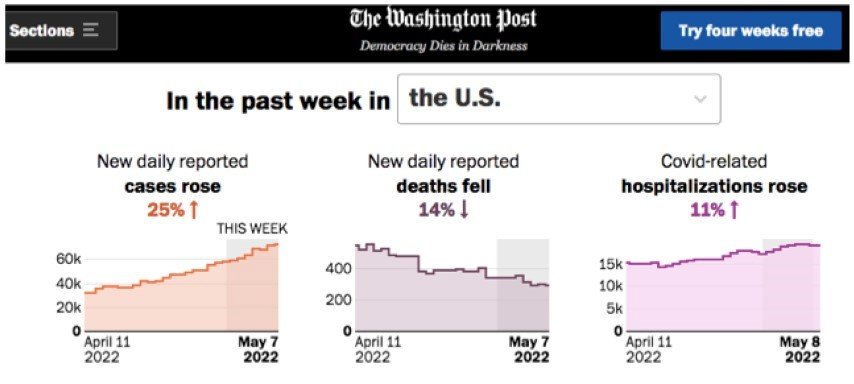Large gatherings, and the resulting covid-19 cases coming from them, have been in the news lately. It’s interesting that a lot of the national news has the viewpoint that it’s not really news at all, it’s just par for the course, nothing more you can do about it, everyone knew the risk, the event was worth it, if you want to do better, go get another shot, and the like.
This "nothing more you can do about it” approach is dead wrong. All the recent events I have read about have missed the boat on more than one of the following effective safety measures:
- PCR pre-tests,
- careful symptoms screening,
- great fresh air ventilation, and
- contact tracing.
For example, the Washington correspondents’ dinner required negative tests, but used same-day antigen tests, which are infamous for a high level of false negative results (see Apr. 7th post - and this was known as far back as the Jan. 7th post).
Even though the spring surge continues - U.S. cases up 25% in the last week - few people choose to wear masks any more. Therefore, let’s see how good a job we can do without requiring masks. Here is what I would do if I were hosting a one- or two-day gathering and wanted to employ all reasonable and effective measures to reduce the covid-19 risk (with references to previous posts).
Before the gathering:
- let everyone know what will be the “rules of the road” including a clear list of symptoms
- anyone with a hint of any of the symptoms, please stay home (Jan. 20th post)
- require a negative PCR test, preferably within 24 hours of arrival—48 hours at the most (Apr. 7th post and Jan. 20th post)
- I would not require vaccination, boosting, or recent “natural immunity” (Mar. 29th post and Jan. 27th post).
Upon arrival at the gathering:
- ask each person to make sure they don’t have any of the symptoms on the list
- collect the proof of negative PCR test results, or ask participants for verbal confirmation
- confirm contact information to allow good contact tracing.
Holding the gathering:
- arrange to hold the event, or most of it, outside
- if not possible for the whole event, have excellent fresh air ventilation for the inside portions
- excellent ventilation to me is twice the CDC/WHO levels, that is, CO2 less than 600 ppm (or higher if supplemented by in-room air purification)
- present the CO2 readings prominently with large meters such as those available via this web site (Apr. 29th post)
- do no dining inside—a serving line can be inside, but the seating will be outside (Dec. 15th post)
- do no singing inside (about double the risk, upcoming blog post).
After the gathering:
- ask participants to get a PCR test right away at the first hint of any symptoms
- ask participants to promptly report any positive test results
- set up a group email or equivalent so participants can self-report their positive test results without violating HIPAA
- participants may want to check to see if they have an asymptomatic case by doing a PCR test (or two, Mar. 29th post) three days after the event
- participants may want to isolate until they get their negative test results.
If these steps are followed, organizers will know that they have literally done everything practical and effective to minimize the risk. Of course, individuals may choose to mask up for a bit of additional safety for themselves and those around them.
To get one of the meters mentioned above, properly calibrated per CDC and WHO recommendations, email (safetulator@kohlerandlewis.com) or call Suzanne (603-352-4828)—the price is $229, including shipping.
Highlights From Past Blogs
April 29 - The Big Meter
April 7 - How to Test
February 25 - One. Million. Deaths.
February 16 - Ventilation Revolution
February 2 - Covid-19 Testing
January 11 - Air Purifiers
January 4 - Masks That Actually Work
December 15 - The Double Risk of Indoor Dining


